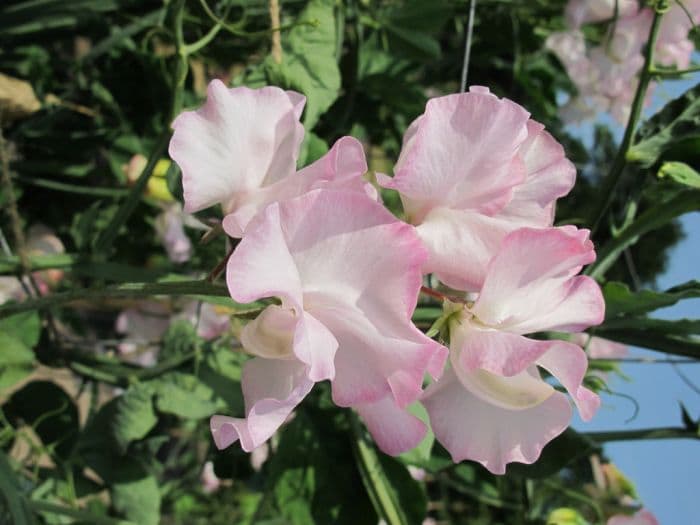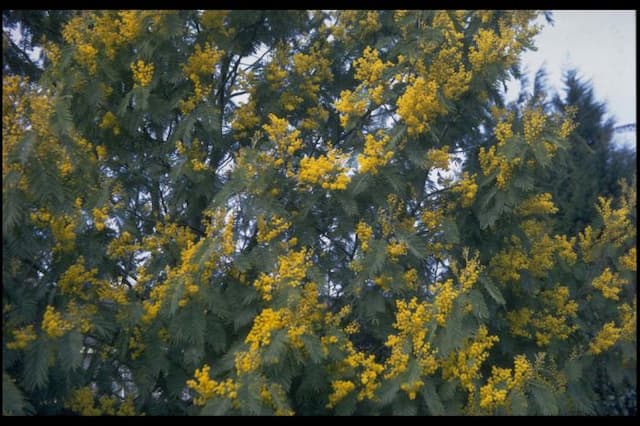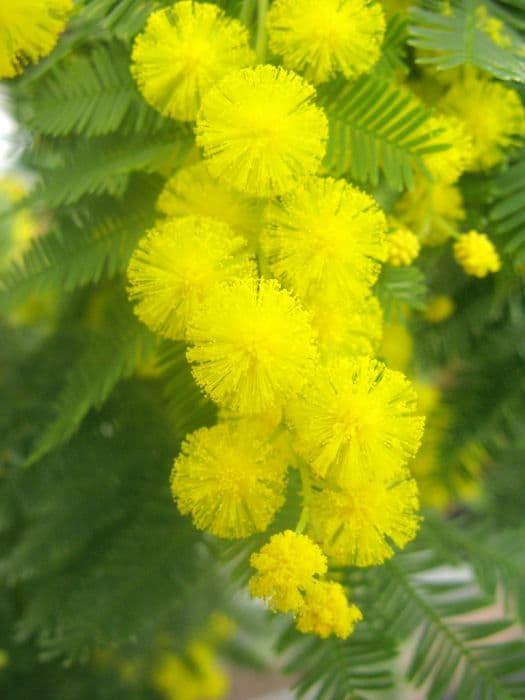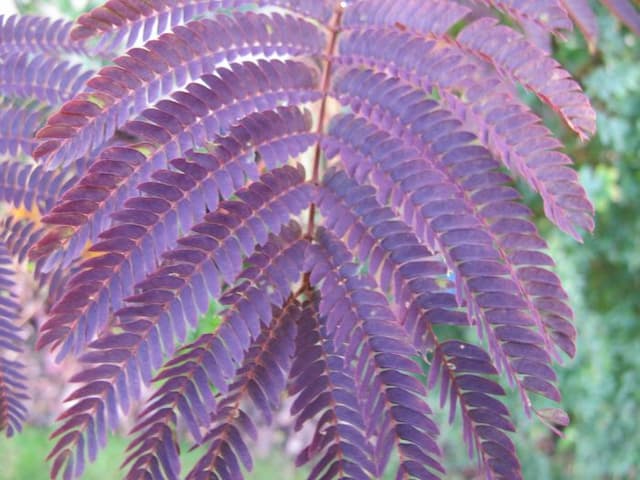Sweet pea Lathyrus odoratus 'Jacqueline Heather'

ABOUT
The sweet pea known as 'Jacqueline Heather' is admired for its captivating appearance, composed of exquisite flowers that add a splash of romance to any garden display. The blooms present a delightful blend of colors, with petals ranging from deep to soft pinks, often with delicate veining that contributes to their unique charm. The flowers are typically ruffled, fostering a sense of opulence, and they form a beautiful contrast with the plant's fresh green foliage. Gracefully adorning the climbing stems, these sweet pea flowers exude a delightful fragrance that can fill the surrounding air with a sweet, intoxicating scent, reminiscent of old-fashioned gardens. The leaves are pinnate, meaning they are comprised of multiple leaflets arranged on either side of a common axis, and they help to create an attractive backdrop for the showy blossoms. Resembling fluttering butterflies, the blossoms come in clusters, inviting onlookers and pollinators alike to enjoy their sumptuous display. As a sweet pea variety, 'Jacqueline Heather' retains the classic attributes of these beloved blooms, which have been a favorite of gardeners and floral enthusiasts for generations.
About this plant
 Names
NamesFamily
Fabaceae.
Synonyms
Sweet Pea, Everlasting Pea, Perennial Pea, Sweet Pease.
Common names
Lathyrus odoratus
 Characteristics
CharacteristicsLife cycle
Annuals
Foliage type
Deciduous
Color of leaves
Green
Flower color
Mixed
Height
6 feet [1.83 meters]
Spread
1 foot [0.30 meters]
Plant type
Climber
Hardiness zones
2
Native area
Mediterranean
Benefits
 General Benefits
General Benefits- Attractive Flowers: Lathyrus odoratus 'Jacqueline Heather', commonly known as sweet pea, has visually appealing flowers that are highly valued for their bright colors and delicate appearance, enhancing garden aesthetics.
- Fragrance: The sweet pea is well-known for its sweet, pleasant fragrance that adds a sensory appeal to gardens and indoor environments when used in cut flower arrangements.
- Pollinator Friendly: Sweet peas attract bees and butterflies, supporting pollinator populations and promoting biodiversity in the garden.
- Vertical Interest: This climber can grow along trellises, fences, or supports, adding vertical interest and structure to garden designs.
- Cut Flowers: The flowers of sweet pea make excellent cut flowers for bouquets and arrangements, with their long stems and vibrant colors.
- Easy to Grow: Sweet peas are known for being easy to cultivate, making them suitable for gardeners of all skill levels.
- Variety of Colors: This cultivar comes in a range of colors, offering versatility and the opportunity to create visually striking color themes in landscaping.
- Seasonal Interest: Sweet peas typically flower in the spring and early summer, providing seasonal interest and marking the transition from spring to summer in temperate climates.
 Medical Properties
Medical PropertiesThis plant is not used for medical purposes.
 Air-purifying Qualities
Air-purifying QualitiesThis plant is not specifically known for air purifying qualities.
 Other Uses
Other Uses- Craft Projects: Dried sweet pea petals can be used in craft projects such as making homemade paper or adding a floral touch to candles.
- Floral Water: Infusing water with the essence of sweet pea flowers can be used for a fragrant room spray or linen mist.
- Insect Repellent Sachets: Sweet pea flowers can be dried and made into sachets that, when placed in wardrobes or drawers, help repel moths and other insects.
- Educational Tools: Sweet pea flowers can be used in classrooms to teach students about pollination, plant biology, and the importance of bees.
- Coloring Agent: The petals of the sweet pea can be used as a natural dye for fabrics, Easter eggs, or homemade cosmetics.
- Photography: The vibrant blooms of sweet peas are popular subjects for photographers looking to learn or showcase macro photography skills.
- Perfume Industry: While typically not directly used in perfumes, the scent of sweet pea can inspire fragrances and be used in the creation of perfume scent profiles.
- Culinary Garnish: Although not edible, sweet pea flowers can be used temporarily to decorate dishes and drinks in upscale dining experiences as long as they're removed before consumption.
- Flower Language and Symbolism: Sweet peas can be studied for their role in floriography—the language of flowers—where they are often associated with pleasurable or delicate experiences.
- Art Inspiration: The natural beauty of sweet peas frequently captures the imagination of artists and can be used as muses for paintings, drawings, or fabric designs.
Interesting Facts
 Feng Shui
Feng ShuiSweet pea is not used in Feng Shui practice.
 Zodiac Sign Compitability
Zodiac Sign CompitabilitySweet pea is not used in astrology practice.
 Plant Symbolism
Plant Symbolism- Pleasure: The sweet pea, known for its delightful scent, symbolizes pleasure and enjoying the blissful moments in life.
- Goodbye: It's often used to convey a fond farewell, as it can signify the end of a good time or the departure from a loved one.
- Blissful Pleasure: A heightened form of pleasure, representing intense joy and happiness.
- Delicate Pleasure: The sweet pea's delicate appearance represents the fragile and often fleeting nature of pleasure.
- Thank You: Sweet peas are a symbol of appreciation, making them a perfect token of gratitude.
- Departure: Similar to goodbye, sweet pea can symbolize embarking on a new journey or change in perspective.
 Water
WaterSweet peas, including 'Jacqueline Heather', prefer to be watered deeply and infrequently, allowing the soil to dry out slightly between waterings. Generally, aim to water once a week with about 1 to 1.5 gallons of water per plant, depending on weather conditions. During hot or windy weather, they may require more frequent watering, but be cautious as overwatering can lead to root rot. It's important to water at the base of the plant to keep the foliage dry and reduce the risk of fungal diseases.
 Light
LightSweet peas like 'Jacqueline Heather' thrive in full sun, where they receive at least 6 to 8 hours of direct sunlight daily. The best spot for them is in a well-lit area that gets morning sunlight and some afternoon shade, particularly in hot climates to prevent the blooms from fading quickly.
 Temperature
TemperatureSweet peas, including 'Jacqueline Heather', perform best in cool to moderate temperatures, ideally between 55°F and 65°F. They can tolerate a minimum temperature of about 40°F and a maximum of around 75°F, but prolonged exposure outside this range can hinder growth and flowering.
 Pruning
PruningSweet peas, including the variety 'Jacqueline Heather', should be pruned to encourage bushier growth and more blooms. Pinch out the tips when the plants are about 4-6 inches tall. Deadheading spent flowers regularly will also promote continuous blooming. The best time for pruning is when the plant has produced several pairs of true leaves.
 Cleaning
CleaningAs needed
 Soil
SoilSweet pea 'Jacqueline Heather' thrives in well-draining, rich, loamy soil with a pH range of 6.0 to 7.5. To create an optimal soil mix, incorporate compost or well-rotted manure into the garden soil to enhance fertility and improve drainage. Mulching can help retain moisture and keep roots cool.
 Repotting
RepottingSweet pea 'Jacqueline Heather' is typically grown as an annual and therefore does not require repotting. Sow seeds directly in the garden each year or start indoors in peat pots before transplanting outdoors to minimize root disturbance.
 Humidity & Misting
Humidity & MistingSweet pea 'Jacqueline Heather' prefers moderate humidity levels but is quite adaptable. Ensure good air circulation around plants to prevent diseases that can occur in high humidity conditions.
 Suitable locations
Suitable locationsIndoor
Provide full sun, rich soil, and cooler temperatures.
Outdoor
Full sun, well-drained soil, support for climbing, water regularly.
Hardiness zone
2-11 USDA
 Life cycle
Life cycleSweet pea 'Jacqueline Heather' begins its life cycle when the seed is sown into well-draining soil, ideally in early spring or late autumn. Germination occurs within 7 to 15 days, after which the seedling emerges, growing its first true leaves and developing a root system. As it transitions into the vegetative stage, the plant grows rapidly, producing climbing stems and characteristic pinnate leaves that require support such as a trellis. Flower buds develop as the plant matures, leading to a blooming phase where fragrant, purple-pink flowers are produced, particularly abundant in cool, temperate conditions. Following pollination, typically facilitated by bees and other insects, the plant sets seed pods, and once the seeds are mature, they can be harvested for subsequent planting. In the final stage, the plant begins to senesce and will eventually die back, especially if exposed to frost, completing its annual life cycle.
 Propogation
PropogationPropogation time
Spring
Propogation: The Sweet Pea 'Jacqueline Heather' can be propagated effectively by sowing seeds, and the ideal time to start this process is in late winter to early spring. The most popular method to propagate Sweet Pea 'Jacqueline Heather' is through seed propagation. To do this, soak the seeds in water for 24 hours to soften the hard outer shell, which can speed up germination. After soaking, plant the seeds about 1 inch (2.54 centimeters) deep in pots or trays filled with moist potting soil. Keep the soil temperature around 55 to 65 degrees Fahrenheit (13 to 18 degrees Celsius) for optimal germination, which typically occurs in 10 to 21 days. Once the seedlings have developed a few sets of true leaves, they can be hardened off and transplanted outdoors after the danger of frost has passed. It's important to plant them in a location that receives full sun to partial shade and has well-draining soil to promote healthy growth.









